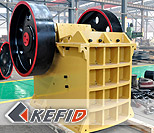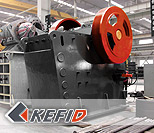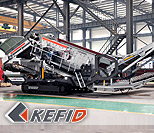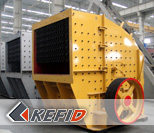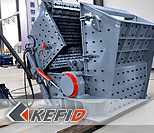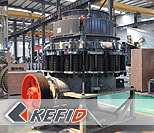Home - News Center - Industry News

Recycled concrete for the 2012 Olympic Village
(UK) -- Mention the word demolition to almost anyone and the picture that instantly comes to mind is a vision of a building being blown up and collapsing to the ground. Many people have stated that they would love to push the button, to detonate the explosive devices which bring a disused building to the ground. In many cases what comes down, must go up and we are seeing many old buildings being demolished to make way for future development, often as part of a regeneration project.
For companies who over many years have built their business around the demolition of buildings, the demolition sector is now far more reaching than just demolishing old buildings. Once the building is demolished the huge task of site clearance begins and in a world where consideration of the environmental impacts are high on most peoples agenda, the material residues from demolition need to be sorted for recycling purposes. This will include such materials as steel, wood, plastic, brickwork and concrete.
Most of the materials can be bulked up and transported to the appropriate recycling plants for reprocessing. Materials such as bricks and concrete can be crushed and turned into a recycled concrete aggregate product ready for reuse in the construction of new roads or buildings. Increasingly though, through advances in technological development, residues such as rubble to be recycled have to meet a very high specification for reuse in construction projects.
Crushed into different grades of recycled aggregate will determine the future usage potential of the product. Large sizes could be used as decorative rockery products in gardening whilst much finer, almost shingle like product can be used as a bedding for pipe laying or as a layer in road construction. With an increasing number of opportunities identified for the reuse of recycled aggregate, the entire demolition and construction industry is making a significant contribution to sustainable development.
Reasons Behind the Increased Focus on Recycling from Construction and Demolition Projects
In 1996, UK Government imposed a tax on all wastes going to landfill. The tax is paid on top of normal gate fees for waste being disposed in landfill and since its introduction the cost has increased on an annual basis. When first introduced, the standard rate of tax for general wastes going to landfill was £7 per tonne and £2 per tonne for inert materials. The tax is designed to encourage commercial and industrial businesses and local authorities collecting from households, to divert waste away from landfill for recycling. In April 2009, the standard rate of landfill tax increased to £40 per tonne and is scheduled to increase each year by £8 per tonne until 2013. The lower rate of tax charged upon any inert materials going to landfill such as concrete and soils, has remained relatively steady in recent years and is currently at £2.50 per tonne.
However, the weight factor alone of a bulk load of these inert materials going directly to landfill will ensure that the entire cost of disposal becomes very expensive and so even in the demolition and construction sector, diverting waste from landfill is a priority. The introduction of landfill tax has been a key driver in encouraging greater diversion of inert materials from landfill, to be used in sustainable development projects.
Following demolition and after passing through the crushing process recycled stone produced from concrete and rubble from the demolished buildings can be used for a variety of purposes.
Next time you see a demolition project in progress or pass any construction site during a build programme, it is clear to see the volume of waste being generated. If waste is not in skips, piles of rubble will be stacked high. The placing of rubble waste in skips has been a major problem for waste contractors for many years. Having worked in the waste industry, I have seen skip lorries tipped backwards with the cab of the vehicle up in the air, due to the sheer overloading of waste skips with construction site waste.
Each year, the UK generates around 330 million tonnes of waste and it is estimated that around 90 million tonnes of this is from construction and demolition wastes. This figure has remained fairly constant since 2001. Around two thirds of this waste is usually recycled or reused in land reclamation or agricultural improvement projects. Since the late 1990s there has been a steady rise in the volumes of construction waste being recycled and this has been helped with advances in technology which have led to improved crushing technology to create more widespread use of different specifications of recycled aggregates.
In recent years, the construction industry as a whole has worked hard to encourage construction project managers to place a greater focus upon recycling on site. This has led to an increase in the recycling of all inert materials from site.
Prior to the introduction of the landfill tax all construction site waste including bricks and concrete would be bulked up and transferred to a landfill site for disposal. No consideration was given to recycling. There are now stringent regulations across the sector, coupled with an increase in environmental awareness, as well as the commercial benefits in ensuring that this type of waste is now recycled. There is also greater recognition of the vast array of opportunities to use recycled aggregates within the construction process on alternative construction projects or in areas such as landscaping or home and garden DIY. Following the demolition process, together the waste concrete, bricks, masonry etc will be transformed into a recycled concrete aggregate. Recycling of aggregates has become a common process for demolition contractors.
To recycle concrete aggregate to a high standard and resalable product, it must be entirely free of other contaminants such as wood, paper, card, steel and other general waste materials. The final product must also conform to the requirements of British Standard BS 8500. The process of recycling the concrete can usually be achieved in one of two ways. Some demolition contractors will transport a crushing machine on the demolition site, whereas some contractors will prefer to transport the waste to be recycled, back to their own premises for sorting for recycling or re-use. On projects where demolition and new construction is to take place at the same location, the contractor is very likely to locate a crushing machine on site to avoid incurring additional transportation costs in taking the material back to a sorting and crushing facility. There is now very sophisticated crushing equipment available to reduce concrete to a very fine specification.
Construction and demolition contractors will look to recycle as much waste as possible from the demolished building.
The Increasing Demand for High Quality Recycled Aggregate
Before commencing the crushing process, it must be determined what the end product is to be used for to ensure that the recycled aggregate is to meet the required standards. There is huge requirement for recycled concrete aggregate to be used back in the construction process.
As a product, recycled concrete aggregate can be used for almost any type of concrete structural work, road surfacing or pipe laying project. Having passed through the crusher the pieces of aggregate will be sorted by size. Bigger pieces may be retained as a decorative product for use in landscaping rockery projects, or they may be passed back through the crusher to be crushed to a smaller size.
The smaller pieces of recycled aggregate may be suitable for use as a gravel on new construction projects, road laying or driveways at home. The crushing machines are now capable of achieving good quality small aggregate grades such as the production of a 20-5mm gravel which can be bagged and used in the garden at home or purchased in bulk as part of projects involving new concrete production.
The advances in technology mean that the recycling of aggregates for other uses such as a simple gravel product or for use in concrete products has greatly reduced the need to dig quarries to mine for gravel. Recycled aggregates have become a versatile reusable product and has eliminated the need for large volumes of a good material to be disposed of in landfill and therefore offer significant environmental benefits.
The demand for high quality crushed aggregate is increasing. There are key standards in place which are focused upon improving the recycled concrete aggregate industry. Through research and development, more widespread uses are being identified for the use of recycled aggregate.
No longer is concrete, just concrete. What we are talking about now are many different grades of recycled aggregate, ranging from the large chunks of aggregate to very specific 6f2 recycled concrete which can be employed as a sub-base material for construction jobs, or 20-5mm recycled aggregate, which is a gravel and can be used in road construction or at home on driveways.
As well as being used as a mix for road construction, recycled aggregate is being used as bedding for pipe laying or foundation material prior to construction projects commencing. In achieving such good quality grades the 20-5mm recycled aggregate can be used as an aggregate base in road construction and the quality meets the standards required to allow its reuse in concrete production.
One of the important criteria when using recycled aggregate is selecting the right specification for the task. For example, when using 20-5mm coarse graded aggregate as a road base, the thickness of the layer required must be determined to withstand traffic flows. Traffic flow on a motorway will be significantly different to that of a country road. One reason aggregate produced to a 20-5mm specification is used as a road base is that it aids good drainage. Once the recycled aggregate is laid, appropriate layers of asphalt or concrete can be laid over it to create the road surface.
In recent years, in the UK we seem to have more rain than sunshine and therefore the selected aggregate must be able to withstand variances in temperature and conditions e.g. dampness for long periods, torrential downpours, long dry spells. With its good drainage qualities, the recycled 20-5mm product is the perfect choice for many sand and gravel applications including, pipe bedding, driveways and footpaths, landscaping, plus for use in ready mixed and precast concrete products.
Demolition contractors look to produce recycled concrete material as part of the site clearance process, in making the site ready for redevelopment.
Recycled Aggregates and the 2012 Olympics
In its bid for the 2012 Olympic Games, London placed sustainability as the focal point of its bid. The bid team identified a major opportunity to increase awareness of climate change and the issues which surround it, and bring it to the World’s attention. With the eyes of the World watching, the Olympic Games present a unique opportunity to communicate key messages about sustainability. Throughout the entire development of the Olympic project, there is a commitment to make 2012 the most sustainable Olympic Games ever held. This focus began when planning the development and build programmes for the facilities and venues, the transport links and network, the hosting of the Games themselves and will end by leaving a long lasting legacy of a sustainable environment.
Since London was awarded the Games, all companies involved in the development requirements, from the construction of the Olympic Stadium, the Olympic Village and transport links to the venues have been focused upon ensuring the use wherever possible of sustainable materials. Across the entire Olympic build programme architects have worked hard to identify suitable sustainable materials for use in the build programme. At the end of the overall project there will be some clearly visible examples of the use of sustainable products.
qually there will be many more much less visible and furthermore, many which will be not visible at all. One of those products which visitors to the games and its many venues will not even think about will be how recycled aggregates have been used as part of the overall construction project. But developers and specifiers of materials for use in the build programme will be comfortable in the knowledge that they have selected sustainable products including, the most appropriate recycled concrete aggregates as part of the project. With its identified qualities, let’s hope that somewhere in the world wide TV coverage the 20-5mm recycled aggregate gets a mention somewhere, somehow.
Conclusion
How times have changed in recent years for the demolition and construction industry. Companies have had to adapt to meet challenging environmental requirements. As with almost any industry, new regulations and legislation dictate the standards to which your business must aspire, if it is to be successful.
Businesses involved in the production of recycled aggregate are no different. These are classed as processed materials and must conform to a particular product specification which can be used in the construction process. The standard BS8500-2 offers a full specification for the uses of recycled concrete aggregates in concrete, although with such a vast range of recycled aggregates an all encompassing specification for the use of these aggregates is yet to be determined. The most important thing is that the industry does not stand still and wait for the specifications to be finalised. The versatility of recycled aggregates means that demolition contractors operating crushing plants are seeking to identify markets through which to sell their recycled products. The advances in crusher technology and machinery has seen a big increase in the options now available in supplying large chunks of recycled aggregate for landscape gardening use in rockeries, down to a gravel type 20-5mm recycled aggregate with its good drainage qualities for use in road construction and driveways. The demolition and construction industry now places sustainability at the forefront of its future development projects.
March 21, 2013
Activities of price cuting for Coal crushersMarch 06, 2013
Improve the Quality of Spare Parts is is NecessaryJanuary 29, 2013
The development of cone crusher industrySeptember 03, 2012
The Trend of Cone CrusherJuly 09, 2012

